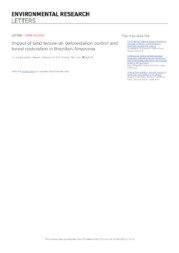Impact of land tenure on deforestation control and forest restoration in Brazilian Amazonia.
Impact of land tenure on deforestation control and forest restoration in Brazilian Amazonia.
Author(s): CAMARA, G.; SIMÕES, R.; RUIVO, H. M.; ANDRADE, P. R.; SOTERRONI, A. C.; RAMOS, F. M.; RAMOS, R. G.; SCARABELLO, M.; ALMEIDA, C.; SANCHES, I.; MAURANO, L.; COUTINHO, A. C.; ESQUERDO, J. C. D. M.; ANTUNES, J. F. G.; VENTURIERI, A.; ADAMI, M.
Summary: This study examines how land tenure constrains Brazil's ability to meet its deforestation control and forest restoration goals in its Amazonia biome. Our findings are based on an updated assessment of land tenure and land use in the region. Between 2019 and 2021, 44% of deforestation in Amazonia occurred in private lands, while forest removal in settlements ranged from 31% to 27% of the total. Deforestation in undesignated public lands increased from 11% in 2008 to 18% in 2021. Deforestation is highly concentrated, with 1% of properties accounting for 82.5% of forest cuts in 2021. In Amazonia, there is considerable non-compliance with the legal reserve provisions set by Brazil's Forest Code. Legal reserve deficits in private lands sum up to 18.17?Mha (million hectares), compared with 12.49?Mha of legal reserve surpluses. Even if all forest surpluses are offered in the forest credits market set in the Forest Code, farmers still need to restore 5.67?Mha to comply with the law. Large-scale cattle ranchers have a legal reserve deficit of 10.35?Mha (34% of their area). Most crop farming occurs in medium and large properties (4.63?Mha) with a large proportion of legal reserve deficits (45%). Given the political power and financial resources of large ranchers and crop producers, Brazil faces major challenges in inducing these farmers to meet their legal obligations. Therefore, Brazil needs to combine robust command-and-control strategies with market-based policies to achieve its deforestation and forest restoration goals. The government should tailor forest protection and restoration policies to the needs of different landowners, considering their land use practices, technical capacity, and financial resources.
Publication year: 2023
Types of publication: Journal article
Keywords: Brazilian Amazonia, Brazil´s Forest Code, Brazil´s NDC, CAR, Cadastro Ambiental Rural, Código florestal brasileiro, Deforestation, Desmatamento, Environmental impact, Forest restoration, Impacto Ambiental, Land ownership, Land tenure, Land use, Land use policy in Brazil, Política de uso da terra no Brasil, Posse de Terra, Recuperação florestal
Observation
Some of Embrapa's publications are published as ePub files. To read them, use or download one of the following free software options to your computer or mobile device. Android: Google Play Books; IOS: iBooks; Windows and Linux: Calibre.
Access other publications
Access the Agricultural Research Database (BDPA) to consult Embrapa's full library collection and records.
Visit Embrapa Bookstore to purchase books and other publications sold by Embrapa.

